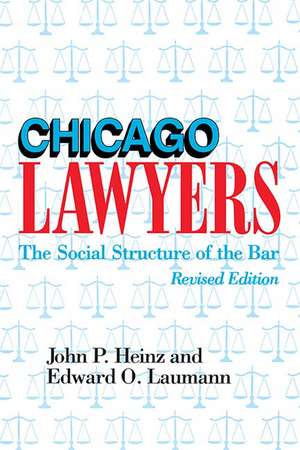Chicago Lawyers, Revised Edition: The Social Structure of the Bar
Autor John Heinz, Edward Laumannen Limba Engleză Paperback – 12 oct 1994
The legal profession is stratified primarily by the character of the clients served, not by the type of legal service rendered, as John P. Heinz and Edward O. Laumann convincingly demonstrate. In their classic study of the Chicago bar, the authors draw on interviews with nearly 800 lawyers to show that the profession is divided into two distinct hemispheres–corporate and individual–and that this dichotomy is reflected in the distribution of prestige among lawyers.
Preț: 216.64 lei
Preț vechi: 241.20 lei
-10% Nou
Puncte Express: 325
Preț estimativ în valută:
41.46€ • 43.59$ • 34.25£
41.46€ • 43.59$ • 34.25£
Carte indisponibilă temporar
Doresc să fiu notificat când acest titlu va fi disponibil:
Se trimite...
Preluare comenzi: 021 569.72.76
Specificații
ISBN-13: 9780810111899
ISBN-10: 0810111896
Pagini: 260
Dimensiuni: 152 x 229 x 20 mm
Greutate: 0.4 kg
Ediția:2
Editura: Northwestern University Press
Colecția Northwestern University Press
ISBN-10: 0810111896
Pagini: 260
Dimensiuni: 152 x 229 x 20 mm
Greutate: 0.4 kg
Ediția:2
Editura: Northwestern University Press
Colecția Northwestern University Press
Notă biografică
JOHN P. HEINZ is the Owen L. Coon Professor of Law at Northwestern University and Distinguished Research Fellow of the American Bar Foundation. Edward O. Laumann is the George Herbert Mead Distinguished Professor of Sociology and former provost of the University of Chicago.
Cuprins
List of Tables
List of Figures
Preface to the Revised Edition
Preface to the Original Edition
Chapter 1. The Scope and Nature of the Study
The Data Set
Some Characteristics of Chicago Lawyers
The Profession: Context
Is Chicago Typical?
Chapter 2. The Organization of Lawyers' Work
The Fields of Law
Distribution of Lawyers' Effort Among the Fields of Law
Level of Specialization in the Fields of Law
Patterns of Co-Practice Among Fields of Law
Conclusion
Chapter 3. Social Differentiation within the Profession
The Degree of Differentiation
The Dimensions of Differentiation
Conclusions
Chapter 4. Honor among Lawyers
The Prestige Order
The Structure of Prestige
Correlates of Prestige: Imputed Characteristics
Correlates of Prestige: Practitioner Characteristics
Multivariate Models of Prestige
Conclusions
Chapter 5. The Constituencies of "Notable" Chicago Lawyers
The Likelihood of Knowing Notables
The Characteristics of the Notables
Biographical Sketches of Notables
Smallest Space Analysis of Notables' Networks
The Notables' Space as Defined by Respondent Characteristics
The Spheres of Influence
Chapter 6. The Hemispheres of the Legal Profession: Summary and Speculation
Size, Separation, and Specialization of the Two Hemispheres
The Legal and Medical Professions Compared
Interests from Within and Without
Sources of the Profession's Social Organization
Corporate Lawyers and their Clients: Further Thoughts on the Allocation of Autonomy
Functional and Conflct Perspectives Reexamined
Conclusion
List of Figures
Preface to the Revised Edition
Preface to the Original Edition
Chapter 1. The Scope and Nature of the Study
The Data Set
Some Characteristics of Chicago Lawyers
The Profession: Context
Is Chicago Typical?
Chapter 2. The Organization of Lawyers' Work
The Fields of Law
Distribution of Lawyers' Effort Among the Fields of Law
Level of Specialization in the Fields of Law
Patterns of Co-Practice Among Fields of Law
Conclusion
Chapter 3. Social Differentiation within the Profession
The Degree of Differentiation
The Dimensions of Differentiation
Conclusions
Chapter 4. Honor among Lawyers
The Prestige Order
The Structure of Prestige
Correlates of Prestige: Imputed Characteristics
Correlates of Prestige: Practitioner Characteristics
Multivariate Models of Prestige
Conclusions
Chapter 5. The Constituencies of "Notable" Chicago Lawyers
The Likelihood of Knowing Notables
The Characteristics of the Notables
Biographical Sketches of Notables
Smallest Space Analysis of Notables' Networks
The Notables' Space as Defined by Respondent Characteristics
The Spheres of Influence
Chapter 6. The Hemispheres of the Legal Profession: Summary and Speculation
Size, Separation, and Specialization of the Two Hemispheres
The Legal and Medical Professions Compared
Interests from Within and Without
Sources of the Profession's Social Organization
Corporate Lawyers and their Clients: Further Thoughts on the Allocation of Autonomy
Functional and Conflct Perspectives Reexamined
Conclusion
Recenzii
"This major contribution to the study of the legal profession is certain to become a standard reference and resource in the field." –Choice
"A major achievement . . . For anyone with a serious empirical interest in the legal profession, Chicago Lawyers clearly sets the standard for future work in the field." –American Journal of Sociology
"Chicago Lawyers is the most comprehensive study of the bar of a major American city. Its sound empirical foundation and provactive theoretical framework have shaped the understanding of a generation of researchers and students." —Richard L. Abel, UCLA
Descriere
The legal profession is stratified primarily by the character of the clients served, not by the type of legal service rendered, as John P. Heinz and Edward O. Laumann convincingly demonstrate. In their classic study of the Chicago bar, the authors draw on interviews with nearly 800 lawyers to show that the profession is divided into two distinct hemispheres–corporate and individual–and that this dichotomy is reflected in the distribution of prestige among lawyers.
